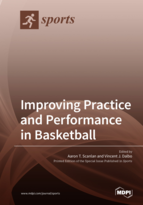Improving Practice and Performance in Basketball
A special issue of Sports (ISSN 2075-4663).
Deadline for manuscript submissions: closed (31 July 2018) | Viewed by 77640
Special Issue Editors
Interests: basketball; team sport; fitness and performance assessment; monitoring in sport
Director, Clinical Biochemistry Laboratory, Central Queensland University, Rockhampton, QLD 4701, Australia
Interests: aging; skeletal muscle; disease prevention; oxidative stress, public health
Special Issues, Collections and Topics in MDPI journals
Special Issue Information
Dear Colleagues,
Baskeball is an international team sport, played across various competition levels by males and females, in over 200 countries. Despite the global popularity of basketball, limited research has been published regarding basketball practice and performance compared to other team sports. As a result, the aim of this Special Issue is to collate submissions specific to basketball on topics that may include, but are not limited to, fitness and performance assessment, player monitoring, training approaches, nutritional and recovery strategies, fatigue, technological advances, psychology, skill development, game-related statistics, and coaching. We are particulalry interested in submissions with applied outcomes for basketball practitioners centred on improving practices in basketball and aspects of player performance. Meta-anlayses, reviews, perspectives, opinion articles, commentaries, and original work will be considered for publication.
Dr. Aaron Scanlan
Dr. Vincent Dalbo
Guest Editor
Manuscript Submission Information
Manuscripts should be submitted online at www.mdpi.com by registering and logging in to this website. Once you are registered, click here to go to the submission form. Manuscripts can be submitted until the deadline. All submissions that pass pre-check are peer-reviewed. Accepted papers will be published continuously in the journal (as soon as accepted) and will be listed together on the special issue website. Research articles, review articles as well as short communications are invited. For planned papers, a title and short abstract (about 100 words) can be sent to the Editorial Office for announcement on this website.
Submitted manuscripts should not have been published previously, nor be under consideration for publication elsewhere (except conference proceedings papers). All manuscripts are thoroughly refereed through a single-blind peer-review process. A guide for authors and other relevant information for submission of manuscripts is available on the Instructions for Authors page. Sports is an international peer-reviewed open access monthly journal published by MDPI.
Please visit the Instructions for Authors page before submitting a manuscript. The Article Processing Charge (APC) for publication in this open access journal is 1800 CHF (Swiss Francs). Submitted papers should be well formatted and use good English. Authors may use MDPI's English editing service prior to publication or during author revisions.
Keywords
- Time-motion analysis
- Training load
- Strength and conditioning
- Physiology
- Skills
- Game statistics








